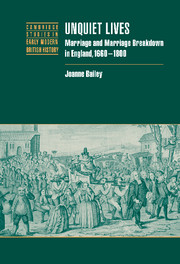Book contents
- Frontmatter
- Contents
- Acknowledgements
- List of abbreviations and conventions
- 1 Introduction: reassessing marriage
- 2 ‘To have and to hold’: analysing married life
- 3 ‘For better, for worse’: resolving marital difficulties
- 4 ‘An honourable estate’: marital roles in the household
- 5 ‘With all my worldly goods I thee endow’: spouses' contributions and possessions within marriage
- 6 ‘Wilt thou obey him, and serve him’: the marital power balance
- 7 ‘Forsaking all other’: marital chastity
- 8 ‘Till death us do part’: life after a failed marriage
- 9 ‘Mutual society, help and comfort’: conclusion
- Appendices
- Bibliography
- Index
- Titles in the series
6 - ‘Wilt thou obey him, and serve him’: the marital power balance
Published online by Cambridge University Press: 27 July 2009
- Frontmatter
- Contents
- Acknowledgements
- List of abbreviations and conventions
- 1 Introduction: reassessing marriage
- 2 ‘To have and to hold’: analysing married life
- 3 ‘For better, for worse’: resolving marital difficulties
- 4 ‘An honourable estate’: marital roles in the household
- 5 ‘With all my worldly goods I thee endow’: spouses' contributions and possessions within marriage
- 6 ‘Wilt thou obey him, and serve him’: the marital power balance
- 7 ‘Forsaking all other’: marital chastity
- 8 ‘Till death us do part’: life after a failed marriage
- 9 ‘Mutual society, help and comfort’: conclusion
- Appendices
- Bibliography
- Index
- Titles in the series
Summary
WIFE-BEATING CASES AS EVIDENCE
This chapter uses evidence of wife-beating to build a more balanced, dynamic picture of relative power within marriage than those in which men's violence was the result of either their uncontrolled or their frustrated power. It is based on around 600 incidents of domestic violence, 92% of which were carried out by men. Most come to light in the records of justices of the peace and the ecclesiastical courts as primary accusations (458, Appendix 1) and secondary complaints (36, Appendix 8), and an additional 105 reports of wife-beating or spousal murder in the sampled local newspapers are also considered. This evidence reveals attitudes to domestic violence and its perpetrators during a period of change in the expression of theories about social relationships and in legal and popular perceptions of violence. The cases of wife-beating must be carefully placed in their cultural context because ideas about the sexes' capacity for violence were evolving over the course of the sixteenth to nineteenth centuries, despite the fact that it is invariably men who commit the majority of violent offences. The changes are particularly evident in literary portrayals of spousal murder and ‘intimate violence’. In the sixteenth and early seventeenth centuries it was wives' violence that was dangerous and frightening in the public's imagination. Frances Dolan demonstrates that representations of domestic crime portrayed the violent wife as the insubordinate dependent who ‘abuses intimacy’ to kill her husband.
- Type
- Chapter
- Information
- Unquiet LivesMarriage and Marriage Breakdown in England, 1660–1800, pp. 110 - 139Publisher: Cambridge University PressPrint publication year: 2003



